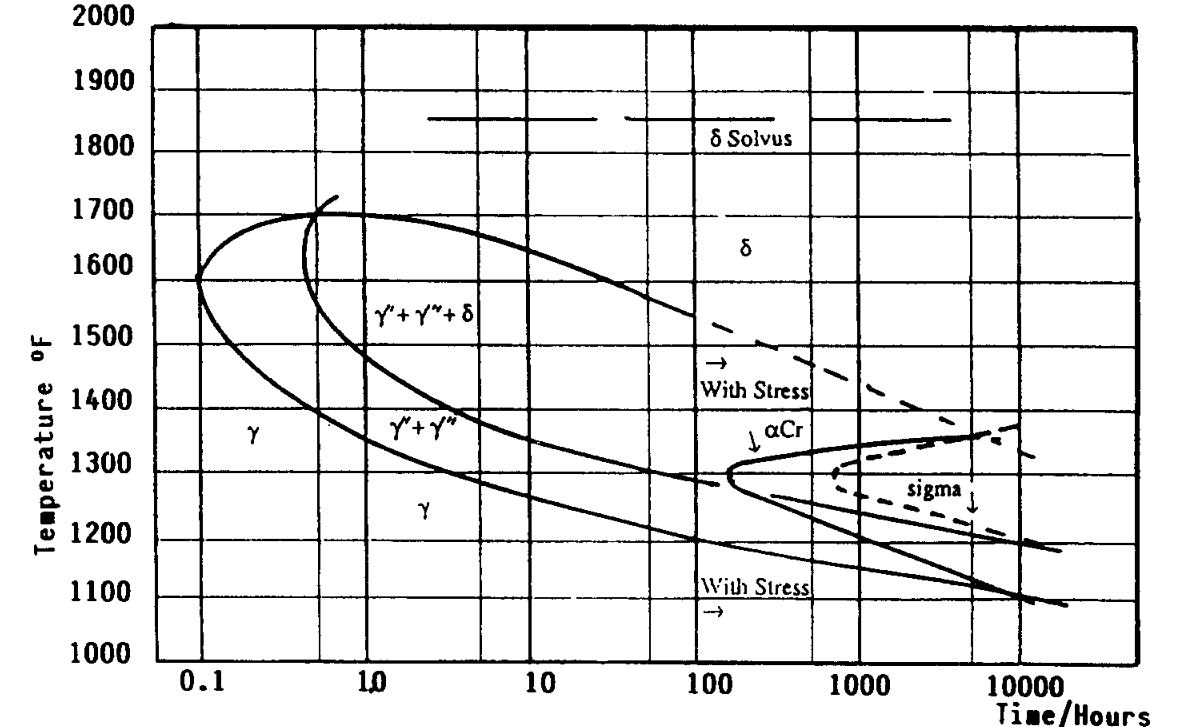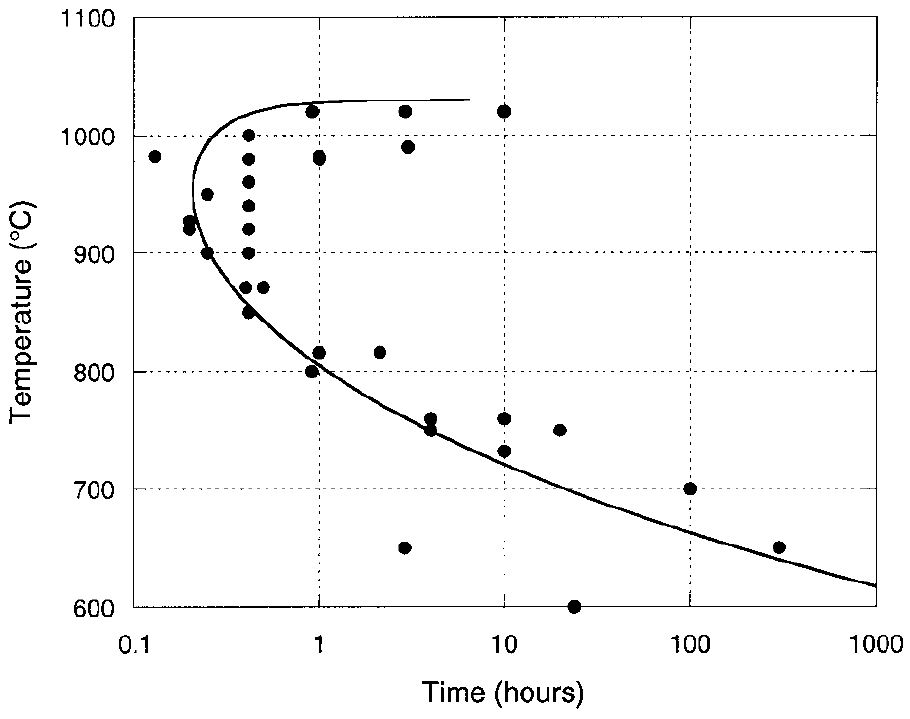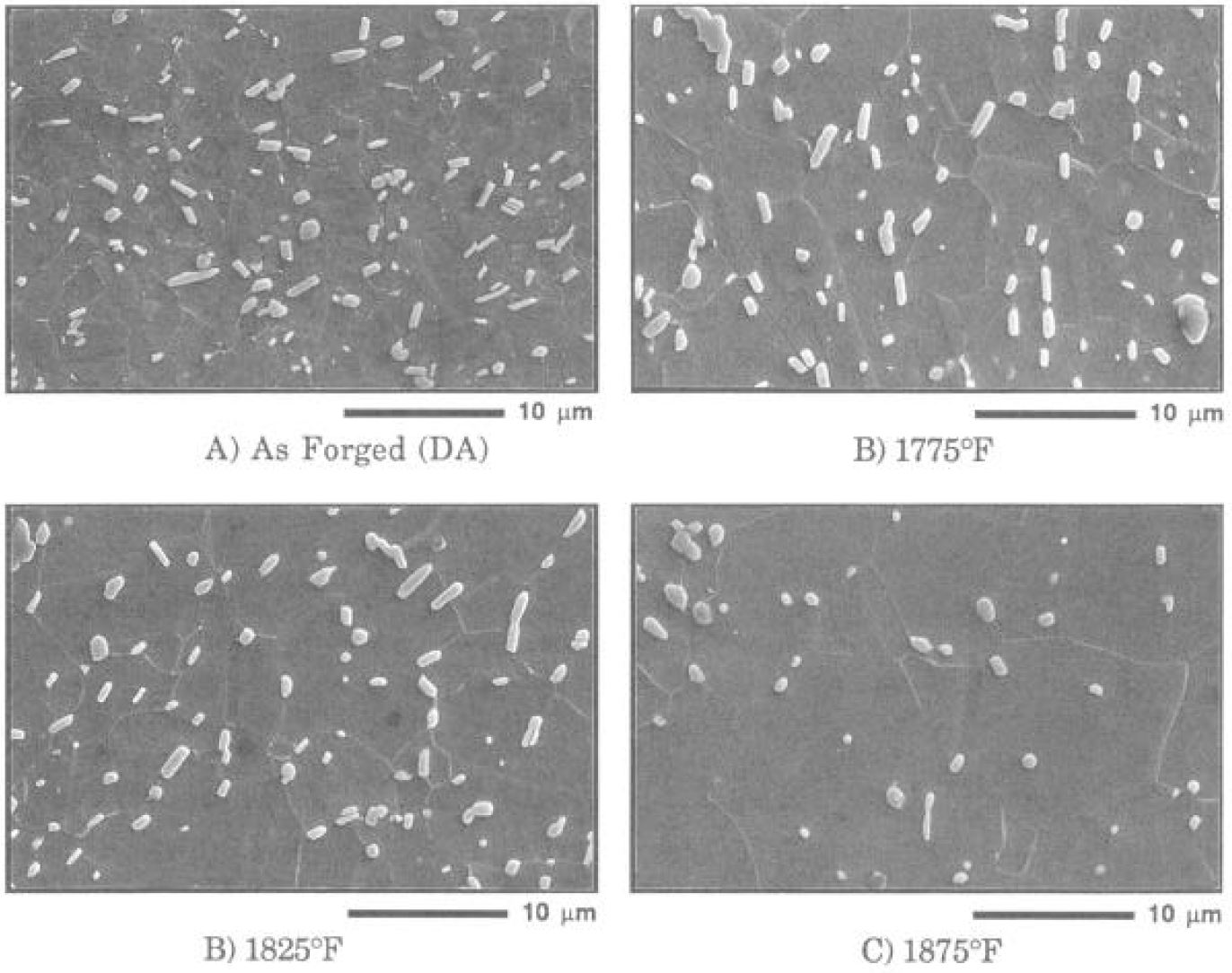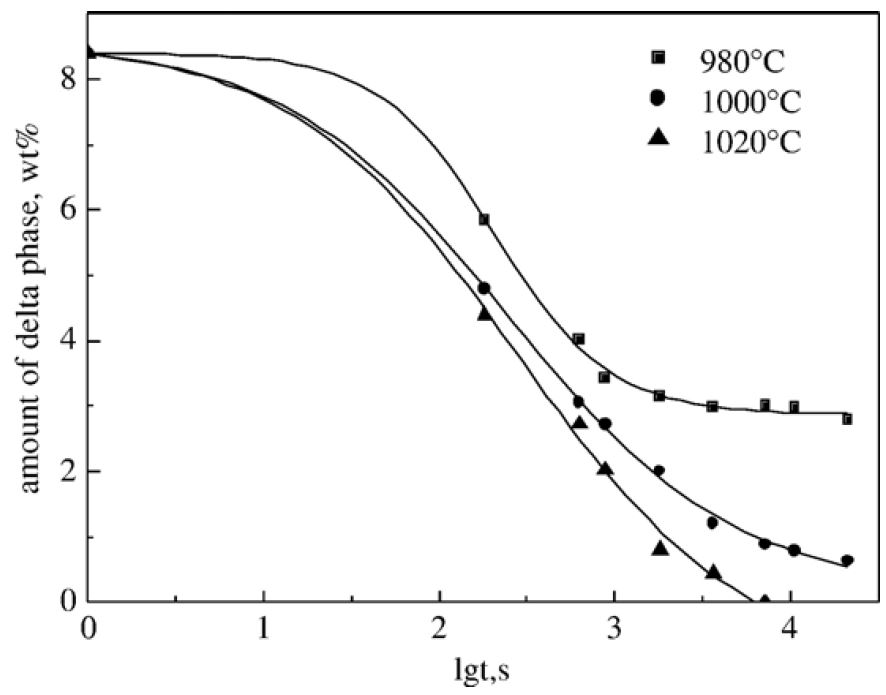Delta Phase in Super-alloy Inconel 718: Its Characterization, Precipitation and Dissolution Kinetics
Info: 2834 words (11 pages) Dissertation
Published: 16th Dec 2019
Tagged: EngineeringMechanics
DELTA PHASE IN SUPER-ALLOY INCONEL 718: ITS CHARACTERIZATION, PRECIPITATION AND DISSOLUTION KINETICS
ABSTRACT
Metastable δ phase in super-alloy Inconel 718 is examined by means of characterization, precipitation and dissolution. Recent time-temperature-transformation diagram as well as the liquidous/solidus temperatures of the precipitations are provided. Equilibrium state of the δ phase from the literature along with the morphological scanning electron microscopy images are included. A model from the literature which is developed for predicting the transformation curve of δ phase is provided including the matching data from the experiments. Findings and key points of the studies for δ phase in Inconel 718 are given in the summary section latterly.
INTRODUCTION
In the last decade, the attention the Ni-based super-alloys attracted has grown incredibly [1]. Among them, owing to the contribution of their superior properties specifically high temperature (up to 700oC) oxidation resistance, today Inconel 718 are the most widely used Ni-based super-alloy in aerospace industry [2]. During the operation conditions, as a result of extensive heat and pressure cycles that are applying to the alloy structure, the microstructural characteristics of Inconel 718 may undergo some transformations and noticeably lower the lifetime of the alloy. In this literature review occurrence of δ phase is examined closer in terms of its characterization, precipitation and dissolution into the matrix.
Characterization of the equilibrium state of δ phase
The typical chemical composition of Inconel 718 is given in Table 1.
Table 1. Chemical composition of Inconel 718 [3].
| Element | Ni | Cr | Mo | Nb | Al | Ti | Fe | Mn | Si | C |
| (wt%) | 53.0 | 18.6 | 3.10 | 5.00 | 0.40 | 0.90 | 18.5 | 0.20 | 0.30 | 0.04 |
Characterization of the equilibrium state of δ phase by disregarding impurity elements and atoms trapped in γ“ precipitates can be simply given as [4]:
| 3Ni+Nb⇔ Ni3Nb(δ) | (1) |
The rate constant, K, is given by [4]:
| K=aδaNi3+aNb | (2) |
where,
a
is the activity of
x
. With the assumption of ideal behavior, the equilibrium conditions are given by [4]:
| -RTlnK=∆G0 | (3) |
where,
∆G0
is the free enthalpy of the formation of δ phase from solid solution. The above equation is used to determine the content of δ phase in regard to the temperature along with δ solvus for any chemical composition [4].
Precipitation of δ phase
The order of precipitation throughout the isothermal heating initiate with small precipitates at grain boundaries. Then proceeds as the growth of grouping small precipitates typically near the grain boundaries. Finally, at higher volumes, the phase gathers along the grains [5]. Besides grain boundaries, Mahadevan et al. [6] similarly observed δ precipitates along coherent/incoherent parts of twin boundaries. This twin boundary mechanism is attributed to the ‘borders of twinned and un-twinned parts’ in the matrix be acting as nucleation sink. This area reported to be along
111
planes, which is correspondingly the habit plane of the δ phase as it was deliberated by Sundararaman et al. [7].
Time-Temperature-Transformation (TTT) diagrams are useful tools to determine various phases precipitating in the alloy during cooling. The very first example of the TTT curves for Inconel 718 case was generated by Eiselstein in 1965 [8] holding MC, M6C, Laves, Ni3Cb and γ` phase transformations. Advancements in technology and variations in composition of Inconel 718 reformed the TTT curves of Inconel 718 [9]. One example TTT diagram for Inconel 718 can be seen in Figure 1.

Figure 1. Time-Temperature-Transformation diagram of Inconel 718 [9].
The major precipitates in Inconel 718 are metastable body-centered-tetragonal (BCT) coherent γ“ phase and face-centered-cubic (FCC) coherent γ` phase which both are the main strengthening phases precipitating in the austenitic matrix [2]. Their characteristic temperatures determined by DTA experiments among different manufacturing types of Inconel 718 are given in Table 2 below.
Table 2. Characteristic temperatures (oC) of phase transformations in Inconel 718 determined by DTA at ramp rates of 40oC/min [3].
| Material | Process | Liquidous | Solidus | Eutectic
γ/NbC |
Eutectic
γ/Laves |
Ni3Nbδ | γ“ | γ` |
| As-cast | Heating | 1351 | 1243 | 1259 | 1180 | 1136 | 832 | 640 |
| Cooling | 1319 | 1212 | 1249 | 1160 | 1132 | —– | —– | |
| Wrought | Heating | 1354 | 1241 | 1282 | —– | —– | 838 | 670 |
| Cooling | 1323 | 1192 | 1262 | 1152 | 1098 | 732 | —– | |
| Wrought-Grain-Grown | Heating | —– | 1237 | —– | —– | —– | 881 | 718 |
| Cooling | —– | 1189 | —– | 1100 | —– | —– | —– |
In equilibrium conditions the metastable γ“ phase turns into stable orthorhombic Ni3Nb based incoherent δ phase [1, 10, 11]. Transformation of δ from γ“ occurs initially at grain boundaries by cellular reaction. δ phase mainly precipitates heterogeneously due to the different structure regarding FCC matrix [12]. The solvus of the δ phase varies between 990 oC and 1020 oC depending on the Nb composition [5, 11]. At temperatures below solvus, δ phase precipitates through γ“ precipitation whereas at higher temperatures directly from the austenitic matrix [12, 13]. Such transformation may interfere with the alloy properties due to formation kinetics of δ phase. It has been shown that [14, 15] δ phase may develop in the alloy with round shape (see Figure 3) during processing or in service. In the literature, there are numerous studies that take the strengthening effect of γ“ and γ` phases along with toughening effect of δ phase on microstructure and mechanical properties of Inconel 718 parts. Although γ“ precipitation strengthens the alloy, δ phase has significance on stabilization of the grain size [4, 11] as well as improving the high temperature stress value of the super-alloy 718 [6]. Besides, due to its morphology, δ phase does not further increase the alloy’s strength. In fact, it causes it to decrease by depleting γ“ [5]. Essentially, taking control over the δ phase specifically at grain boundaries is believed to be the key point in parts with better mechanical properties [16]. Thus, controlling δ precipitation makes it possible to control microstructural properties to meet the industrial demands for Inconel 718.
Beaubois et al. [11] studied precipitation kinetics of delta phase of Inconel 718 by attempting to quantify the nucleation and growth kinetics of the δ phase of Inconel 718. With the assumption of δ precipitates which are large enough to be spotted by the detection instrument as well as small enough to characterize the initiation of the precipitation, they suggested an expression for
τ
, time needed to reach the above-defined value. For δ phase the value of
τ
is given by [11]:
| τ-1=0.7∆T0.5exp0.05∆T2T+273 | (4) |
where, the units for
τ
is hours and for
T
is Celsius. The curve corresponding the equation above can be seen in Figure 2.

Figure 2. Diagram showing relationship between time and aging temperature for initial precipitation of δ phase: line corresponds to the Equation (4) [11].
It is seen from Figure 2 that curve drawn by using Equation (4) represents majority of the experimental data generated by Beaubois et al. [11].

Figure 3. Scanning electron micrographs showing typical delta phase distribution after one hour solution at the noted temperature [15].
The dissolution kinetics of δ phase
The dissolution kinetics of δ phase in Inconel 718 is investigated by Cai et al. [16]. Change in the amount of δ phase in Inconel 718 can be seen in Figure 4. It is clear from Figure 4 that δ phase amount decreases with increasing holding time at all three given temperatures. It is worth noting that δ phase does not fully dissolve into the matrix at 980 oC rather follows no relationship following some certain holding time.

Figure 4. Dissolution process of δ phase in Inconel 718 at different temperatures [16].
The dissolution of δ phase is a Nb atom controlled diffusion process [15], which advances as short and long range diffusion process [16]. In shorter-range diffusional process, atoms migrate from one side of the phase boundary alongside δ phase to the other side alongside the austenitic matrix [16]. The driving force regarding the flux of atom
JB
across the phase boundary is given by [16]:
| JB∝M∆μB | (5) |
where, M is the migration rate. In longer-range diffusional process, the flux is dominated by the cubic diffusion coefficient and concentration gradient among the phase boundary and the austenitic matrix and is given by [16]:
| JB=D∂CB∂x | (6) |
where,
| D=D0exp-QRT | (7) |
where,
D0
and
Q
are frequency factor and activation energy, respectively. The migration rate of diffusional process atoms migrate from one side of the phase boundary alongside δ phase to the other side alongside the austenitic matrix relies on the accommodation probability which can also be defined as carrying factor [16]. The δ phase and austenitic matrix boundary is reported to be incoherent which approximates the carrying factor to unity. The slowest step is going to act as dominating process which in this case would be the longer-range diffusion process [16].
SUMMARY AND CONCLUSIONS
δ phase in super-alloy Inconel 718 is discussed through characterization, precipitation and dissolution. Equilibrium state of the δ phase from the literature accompanied by the morphological scanning electron microscopy images are investigated. A model which is developed for predicting the transformation of δ phase from the literature is examined. Following conclusions regarding the δ phase may be drawn considering the literature survey done:
- The major precipitates in Inconel 718 are metastable BCT coherent γ“ phase and FCC coherent γ` phase
- Both the γ“ and γ` phases are the main strengthening phases precipitating in the austenitic matrix.
- In equilibrium, the γ“ phase dissolves into orthorhombic Ni3Nb based incoherent δ phase.
- At temperatures below solvus, δ phase precipitates through γ“ precipitation whereas at higher temperatures directly from the austenitic matrix.
- Transformation of δ from γ“ arises initially at grain boundaries by cellular reaction.
- δ phase mainly precipitates heterogeneously in the FCC matrix.
- The solvus of the δ phase varies depending on the Nb composition.
- δ phase has proven to be stabilizing the grain size of the alloy.
- Precipitation of the δ phase throughout isothermal annealing begins with forming of small precipitates at grain boundaries.
- Precipitation of δ phase as well as the nose of the C-curve can be predicted.
- Dissolution of δ phase again relies on the Nb content in the alloy.
REFERENCES
1J. Brooks and P. Bridges, “Metallurgical stability of inconel alloy 718”. Superalloys. 88 33-42 (1988).
2H.Y. Zhang, S.H. Zhang, M. Cheng, and Z.X. Li, “Deformation characteristics of δ phase in the delta-processed Inconel 718 alloy”. Materials Characterization. 61 [1] 49-53 (2010).
3N.B. Dahotre, M.H. McCay, T.D. McCay, C.R. Hubbard, W.D. Porter, and O.B. Cavin, “Effect of grain structure on phase transformation events in the inconel 718”. Scripta Metallurgica et Materialia. 28 [11] 1359-1364 (1993).
4Y. Desvallées, M. Bouzidi, F. Bois, and N. Beaude, “Delta phase in Inconel 718: mechanical properties and forging process requirements”. Superalloys. 718 [625] 281-291 (1994).
5S. Azadian, L.-Y. Wei, and R. Warren, “Delta phase precipitation in Inconel 718”. Materials Characterization. 53 [1] 7-16 (2004).
6S. Mahadevan, S. Nalawade, J.B. Singh, A. Verma, B. Paul, and K. Ramaswamy. Evolution of δ Phase Microstructure in Alloy 718. in 7th Int Symp Superalloys 718 Deriv. 2010.
7M. Sundararaman, P. Mukhopadhyay, and S. Banerjee, “Precipitation of the δ-Ni3Nb phase in two nickel base superalloys”. Metallurgical Transactions A. 19 [3] 453-465 (1988).
8H. Eiselstein, “Metallurgy of a columbium-hardened nickel-chromium-iron alloy”, in Advances in the Technology of Stainless Steels and Related Alloys. 1965, ASTM International.
9A. Oradei-Basile and J.F. Radavich, “A current TTT diagram for wrought alloy 718”. Superalloys. 718 [625] 325-335 (1991).
10C.T. Sims, N.S. Stoloff, and W.C. Hagel, “Superalloys II”. 1987: John Wiley and Sons, New York.
11V. Beaubois, J. Huez, S. Coste, O. Brucelle, and J. Lacaze, “Short term precipitation kinetics of delta phase in strain free Inconel* 718 alloy”. Materials Science and Technology. 20 [8] 1019-1026 (2004).
12Y. Huang and T.G. Langdon, “The evolution of delta-phase in a superplastic Inconel 718 alloy”. Journal of Materials Science. 42 [2] 421-427 (2007).
13J. Barker, “Long Time Behavior of Turbine Materials”. GE Report R65FPD51. (1965).
14S. Li, J. Zhuang, J. Yang, Q. Deng, J. Du, X. Xie, B. Li, Z. Xu, Z. Cao, and Z. Su, “The effect of phase on crack propagation under creep and fatigue conditions in alloy 718”. Superalloys. 718 625-706 (1994).
15A. Dix, J. Hyzak, and R. Singh, “Application of ultra fine grain alloy 718 forging billet”, in Superalloys 1992. 1992, TMS. pp. 23-32.
16D. Cai, W. Zhang, P. Nie, W. Liu, and M. Yao, “Dissolution kinetics of δ phase and its influence on the notch sensitivity of Inconel 718”. Materials Characterization. 58 [3] 220-225 (2007).
Cite This Work
To export a reference to this article please select a referencing stye below:
Related Services
View allRelated Content
All TagsContent relating to: "Mechanics"
Mechanics is the area that focuses on motion, and how different forces can produce motion. When an object has forced applied to it, the original position of the object will change.
Related Articles
DMCA / Removal Request
If you are the original writer of this dissertation and no longer wish to have your work published on the UKDiss.com website then please:




